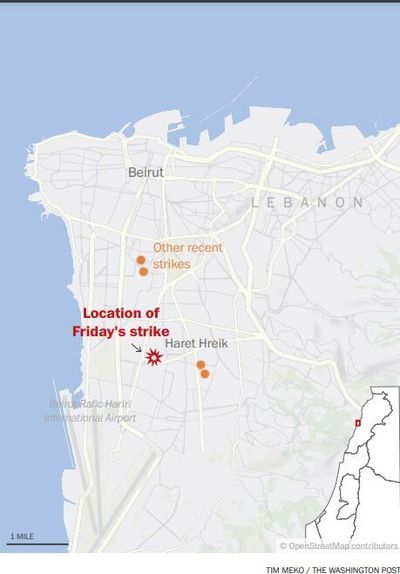Israel strikes Hezbollah’s ‘central headquarters’ in Beirut, IDF says

The Israeli military said it struck the main headquarters of Hezbollah on Friday as residents of Beirut reported large blasts and smoke billowing from neighborhoods in the south of the city. Images and videos shared on social media verified by The Washington Post and accounts from witnesses suggested that the blasts occurred in the southwestern suburbs of the Lebanese capital not far from the city’s airport.
At least two people were killed and 76 injured in the strike, according to an initial toll shared by the Lebanese Ministry of Health. “The rubble removal is ongoing amid expectations that the toll may rise,” the ministry added in a statement.
Daniel Hagari, a spokesman for the Israel Defense Forces, said in a short briefing that the attack, which appeared to be one of the most powerful in Beirut during this latest round of conflict, targeted a command center under a civilian building.
Ziad Waked, the mayor of Haret Hreik, told The Washington Post that six residential buildings were leveled in the strike. Ambulances arrived at the scene, Waked said.
The Lebanese Civil Defense said responders were working to extinguish fires, evacuate the injured and retrieve bodies at the site of the strikes.
Hagari said Israel would provide details later. The attack took place after Israeli Prime Minister Benjamin Netanyahu concluded a speech to the U.N. General Assembly in New York.
Video of the city Friday evening shows large columns of smoke rising. One video filmed from a window shows at least four distinct columns rising above central Beirut. The plumes appear to be dozens of feet wide and high, billowing above the buildings below. Screams are audible in the background.
Footage shared on social media, verified and geolocated by The Washington Post, as well as witness accounts also suggested that at least two buildings were destroyed by the blast.
A video filmed in the immediate aftermath shows at least two craters, both filled by significant amounts of debris. Fire is visible in the background as rescue crews clad in neon yellow vests traverse the landscape of charred building materials in search of survivors.
Warplanes dropped at least five additional munitions after the initial strike, according to a second video verified by The Post. It was not immediately clear from the video what munition was used. After they landed a fire ball erupted, appearing to reach dozens of feet into the air.
“Available videos of the strike show that numerous large air-delivered bombs were used,” N.R. Jenzen-Jones, director of Armament Research Services, wrote in a message to The Post, noting the video suggested at least three impact sites. Jenzen-Jones added that the repeated impacts from multiple munitions suggest they were aimed at penetrating a heavily protected space.
The Defense Department had no involvement in or warning of the latest Israeli strike in Beirut, a Pentagon spokeswoman said Friday.
Sabrina Singh told reporters in a news conference that Defense Secretary Lloyd Austin learned of the strike on Hezbollah’s central headquarters when his Israeli counterpart, Defense Minister Yoav Gallant, called him and told him it was underway. Austin was on his way back to Washington from meetings in London when the call came through, she said.
She declined to say whether Gallant told Austin that Hezbollah leader Hasan Nasrallah was the intended target.